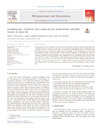Identificador persistente para citar o vincular este elemento:
https://accedacris.ulpgc.es/jspui/handle/10553/77407
| Campo DC | Valor | idioma |
|---|---|---|
| dc.contributor.author | Steinmetzer, Tobias | en_US |
| dc.contributor.author | Wilberg, Sandro | en_US |
| dc.contributor.author | Bönninger, Ingrid | en_US |
| dc.contributor.author | Travieso González, Carlos Manuel | en_US |
| dc.date.accessioned | 2021-02-01T09:04:15Z | - |
| dc.date.available | 2021-02-01T09:04:15Z | - |
| dc.date.issued | 2020 | en_US |
| dc.identifier.issn | 0141-9331 | en_US |
| dc.identifier.uri | https://accedacris.ulpgc.es/handle/10553/77407 | - |
| dc.description.abstract | Gait deviations such as asymmetry are one of the characteristic symptoms of motor dysfunctions that contribute to the risk of falls. Our objective is to measure gait abnormalities such as asymmetry of the lower limbs in order to evaluate the diagnosis more objectively. For the measurement we use inertial measurement unit (IMU) sensors and force sensors, which are integrated in wristbands and insoles. To extend the battery life of wearable devices, we only save data of the activity gait within the wearables. Therefore we perform activity recognition with a smartphone. Using convolutional neural network (CNN) we achieved an accuracy of 94.7 % of the activity gait recognition. Before recording we synchronize the wearable sensors and reach a maximum latencies of 3 ms . Before the analysis of the symmetry we detect the strides by using a CNN with an accuracy of 98.8 %. For the symmetry evaluation we used dynamic time warping (DTW). The DTW enables us to calculate symmetry of the complete time series of human gait. | en_US |
| dc.language | eng | en_US |
| dc.relation.ispartof | Microprocessors and Microsystems | en_US |
| dc.source | Microprocessors and Microsystems [ISSN 0141-9331], v. 77, 103118, (Septiembre 2020) | en_US |
| dc.subject | 3307 Tecnología electrónica | en_US |
| dc.subject.other | Synchronization | en_US |
| dc.subject.other | Gait analysis | en_US |
| dc.subject.other | Inertial sensors | en_US |
| dc.subject.other | Dynamic time warping | en_US |
| dc.subject.other | Convolutional neural networks | en_US |
| dc.subject.other | Symmetry | en_US |
| dc.title | Analyzing gait symmetry with automatically synchronized wearable sensors in daily life | en_US |
| dc.type | info:eu-repo/semantics/article | en_US |
| dc.type | Article | en_US |
| dc.identifier.doi | 10.1016/j.micpro.2020.103118 | en_US |
| dc.investigacion | Ingeniería y Arquitectura | en_US |
| dc.type2 | Artículo | en_US |
| dc.utils.revision | Sí | en_US |
| dc.identifier.ulpgc | Sí | en_US |
| dc.contributor.buulpgc | BU-TEL | en_US |
| dc.description.sjr | 0,323 | |
| dc.description.jcr | 1,525 | |
| dc.description.sjrq | Q3 | |
| dc.description.jcrq | Q3 | |
| dc.description.scie | SCIE | |
| item.fulltext | Con texto completo | - |
| item.grantfulltext | open | - |
| crisitem.author.dept | GIR IDeTIC: División de Procesado Digital de Señales | - |
| crisitem.author.dept | IU para el Desarrollo Tecnológico y la Innovación | - |
| crisitem.author.dept | Departamento de Señales y Comunicaciones | - |
| crisitem.author.orcid | 0000-0002-4621-2768 | - |
| crisitem.author.parentorg | IU para el Desarrollo Tecnológico y la Innovación | - |
| crisitem.author.fullName | Steinmetzer, Tobias | - |
| crisitem.author.fullName | Travieso González, Carlos Manuel | - |
| Colección: | Artículos | |
Citas de WEB OF SCIENCETM
Citations
20
actualizado el 08-jun-2025
Visitas
144
actualizado el 01-jun-2024
Descargas
309
actualizado el 01-jun-2024
Google ScholarTM
Verifica
Altmetric
Comparte
Exporta metadatos
Los elementos en ULPGC accedaCRIS están protegidos por derechos de autor con todos los derechos reservados, a menos que se indique lo contrario.
